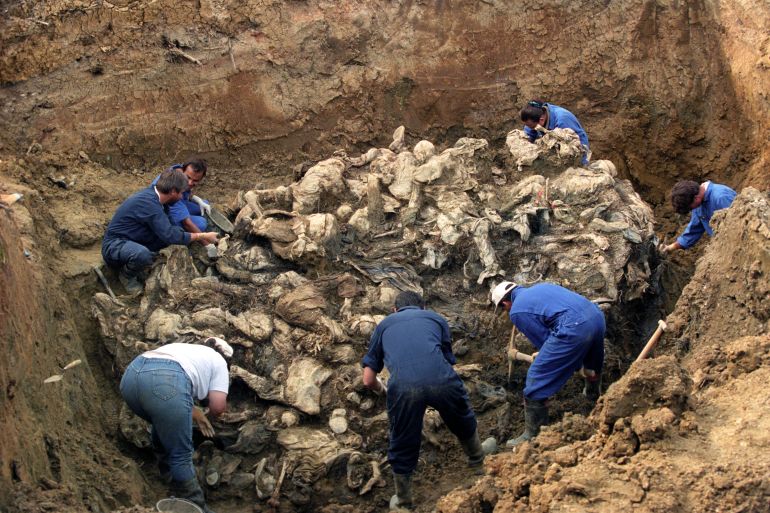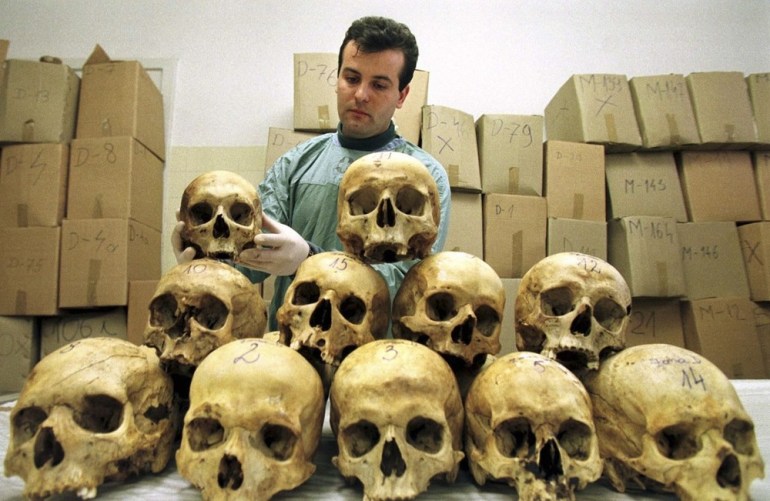Int’l community must protect, preserve mass graves: Callamard
UN expert proposes human rights framework to manage the world’s tens of thousands of mass grave sites.

The international community has a responsibility to protect and preserve mass graves while ensuring cultural and religious rites are respected, according to a report by Agnes Callamard, the United Nations special rapporteur for extrajudicial, summary or arbitrary executions.
Callamard presented her findings to the UN General Assembly in New York on Tuesday.
Keep reading
list of 4 itemsWorld Press Freedom Day: Gaza conflict deadliest for journalists
Israeli firms sold invasive surveillance tech to Indonesia: Report
Abu Ghraib: Iraqi victims’ case against US contractor ends in mistrial
She believes the lawful and culturally sensitive treatment of mass burial sites could aid reconciliation after conflict.
Callamard estimates there are tens of thousands of mass graves in the world; many of past conflicts are still being discovered. In April 2020, for example, a site with 30,000 bodies was found in Rwanda.
The report described the Mediterranean Sea, where thousands of refugees and migrants have drowned while attempting to reach Europe since 2015, as a mass burial site.
Callamard interviewed experts, including those from the Department of Mass Graves in Iraq, which says it has few resources to deal with thousands of such sites.
“The mass graves in Iraq went back to the Saddam Hussein era. They had calculated it will take them more than 800 years to excavate them all and process their precious remains,” said Callamard.
What is a mass grave?
There is no international definition of a mass grave. But forensic experts define a mass grave as a “burial site containing the remains, often commingled, of numerous persons”.
Callamard adopted the following definition: a burial site where the “circumstances surrounding the death and the body disposal method warrant an investigation as to their lawfulness”.
Mass graves are not necessarily burial sites or final resting places. Under a barrage of bombings, Syrian markets, hospitals, schools and homes have been rendered sites of mass burials.
What distinguishes mass graves from other mass burial sites are violations – last rites are denied and there is little regard for the victims’ cultural or religious identities.
Human rights framework
Currently, there is no human rights framework guiding states on how to manage mass graves.
Callamard told Al Jazeera: “In spite of the number of mass graves and their significance, the international community has done very little to guard and protect mass graves and guide their respectful handling.
“The report proposes a preliminary human rights framework that recognises the diversity of claims, rights and obligations implicated by the existence of mass graves. It calls on states to support a multi-stakeholder process towards the development of standards and best practices for the respectful management of mass graves.”
A human rights framework approach, she said, includes transitional justice and peacemaking efforts.
In Callamard’s view, mass graves indicate the prominence of enforced disappearances.

Identification of bodies
Legally, remains belong to and should be returned to the deceased’s family.
In some instances, families have demanded that corpses can be identified – a process that has been state-backed.
Croatia, for example, has developed a model that is aided by technology and supports families who are searching for their missing loved ones. Methods such as aerial photography, cadaver dogs and electronic sensors are being used.
So far, 150 mass graves containing victims of the Croatian War of Independence and World War II have been exhumed.
Ana Filko, an associate at the Directorate of Missing Persons in Croatia, told Al Jazeera: “The prevalence of mass graves and the large number of victims are the best indicators of the character of the aggression suffered.
“The issue of missing persons is important for determining legal and historical facts, which in turn contributes to the criminal prosecution of those responsible.”
According to Jean-Marc Dreyfus, reader in Holocaust studies at the University of Manchester and expert on mass graves, exhumation has to be carried out according to the traditions of a community. International courts, he added, were increasingly relying on mass graves as evidence of state-led crimes.